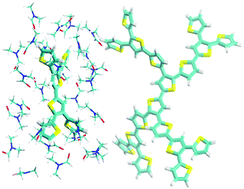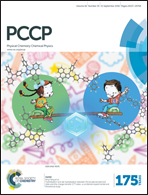Solvent effects on the properties of hyperbranched polythiophenes†
Abstract
The structural and electronic properties of all-thiophene dendrimers and dendrons in solution have been evaluated using very different theoretical approaches based on quantum mechanical (QM) and hybrid QM/molecular mechanics (MM) methodologies: (i) calculations on minimum energy conformations using an implicit solvation model in combination with density functional theory (DFT) or time-dependent DFT (TD-DFT) methods; (ii) hybrid QM/MM calculations, in which the solute and solvent molecules are represented at the DFT level as point charges, respectively, on snapshots extracted from classical molecular dynamics (MD) simulations using explicit solvent molecules, and (iii) QM/MM-MD trajectories in which the solute is described at the DFT or TD-DFT level and the explicit solvent molecules are represented using classical force-fields. Calculations have been performed in dichloromethane, tetrahydrofuran and dimethylformamide. A comparison of the results obtained using the different approaches with the available experimental data indicates that the incorporation of effects associated with both the conformational dynamics of the dendrimer and the explicit solvent molecules is strictly necessary to satisfactorily reproduce the properties of the investigated systems. Accordingly, QM/MM-MD simulations are able to capture such effects providing a reliable description of electronic properties–conformational flexibility relationships in all-Th dendrimers.


 Please wait while we load your content...
Please wait while we load your content...